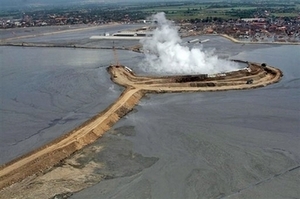An Indonesian "mud volcano" that has oozed sludge for two years is collapsing under its own weight, worsening an environmental disaster that has displaced thousands, a study said Wednesday.
Sudden collapses of up to three metres (9.8 feet) have been recorded at the centre of the volcano in East Java, the study by Durham University and the Bandung Institute of Technology found.
"Such sudden collapses could be the beginning of a caldera -- a large basin-shaped volcanic depression," the institute said in a statement, adding that the caldera could be as much as 146 metres deep.

|
| ©AFP/File/Dwi Narwoko
|
| Gas flows from the crater surrounded by hot mud in Porong, Sidoarjo district. An Indonesian "mud volcano" that has oozed sludge for two years is collapsing under its own weight, worsening an environmental disaster that has displaced thousands, a study said Wednesday.
|